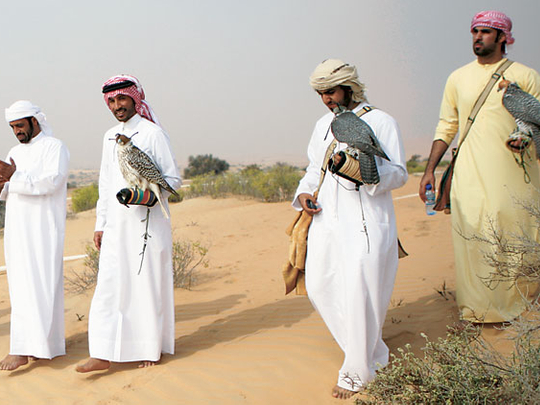
Al Ain: Untiring efforts of the UAE leaders and falconers have taken the sport of falconry to new heights worldwide with its recognition as a living human heritage by Unesco.
The efforts became more visible in the UAE in 1995 with the launching of Falcon Research and Release Programme by late Shaikh Zayed Bin Sultan Al Nahyan under the supervision of President His Highness Shaikh Khalifa Bin Zayed Al Nahyan, who was then Crown Prince of Abu Dhabi.
Shaikh Khalifa was also the then chairman of the Environmental Research and Wildlife Development Agency (ERWDA) and the agency was given the main task. The agency established Abu Dhabi Falcon Hospital in October 1999 and the Emirates Falconers Club. The research efforts were also supported by another institution called the National Avian Research Centre (NARC).
The NARC, established in 1989, supported in the conservation and breeding of the houbara bustard, used as the main bird of prey by Emirati falconers. Since 1999, some 8,704 houbaras have been bred in captivity, of which more than then 3,000 have been released into the wild. The Asian houbara bustard is widely distributed in 23 countries. Some of these birds are migratory and travel thousands of kilometres to reach their winter grounds in the Arabian Peninsula.
The late Shaikh Zayed is renowned internationally for his love of falcons. He is quoted as saying: "We have inherited falconry from our ancestors, during a time when our bonds with nature were stronger and less complicated. This is a constant reminder to us of the forces of nature, and of the relationship between all living creatures that share living on this earth and depend on nature. Our goal is shared: a balanced and sustainable use of our natural resources, in order to leave the earth as we have inherited it or in a better shape than that."
Real beginning
The late Shaikh Zayed's efforts started many years ago as he organised the first International Conference on Falconry and Nature Conservation in Abu Dhabi in late 1976. This was the first time falconers from the Arab world, Europe, North America, and the Far East came together. This was the real beginning towards gathering falconers to discuss the future of the sport and conservation of the bird and its prey.
The UAE also revived the habit of releasing falcons back into the wild at the end of each hunting season. Shaikh Zayed set an example and donated many of his falcons for release. In April 1995, following the world's first-ever satellite tracking of a migrating houbara bustard, also by the UAE, the country released four satellite-tagged saker falcons into the wild in Pakistan to conduct a study on the birds' biology and their migratory routes.
The four sakers were among the 107 female birds, including 27 peregrine falcons and 80 saker falcons, which were released in batches in Pakistan's Balochistan province.
The transmitter tags carried by the birds weigh around 34 grammes and allow the scientists to track them by satellites until the batteries of the transmitters run down in six months. The birds were chosen for their fitness and strength, and were trained to fly and hunt with the extra burden on their backs.
The sport of falconry has been practised in the Arab world for centuries. It is currently practised in the UAE, Belgium, Czech Republic, France, Pakistan, Republic of Korea, Mongolia, Morocco, Qatar, Saudi Arabia, Spain, Syria and some other countries .
Falcons have dozens of known species including sakers, peregrines, gyrfalcons, barbary, and hybrids. They are divided into three or four main groups. These birds are also called raptor for being a bird of prey. The popular falcons used in the Emirates for the sport belong to the peregrine and hawk groups of the bird.
A Unesco report said: "Falconry is transmitted from generation to generation as a cultural tradition by a variety of means, including mentoring, learning within families, or formalised training in clubs."
It forms the basis of a wider cultural heritage, including traditional dress, food, songs, music, poetry and dance, all of which are sustained by the communities and clubs that practice it.











